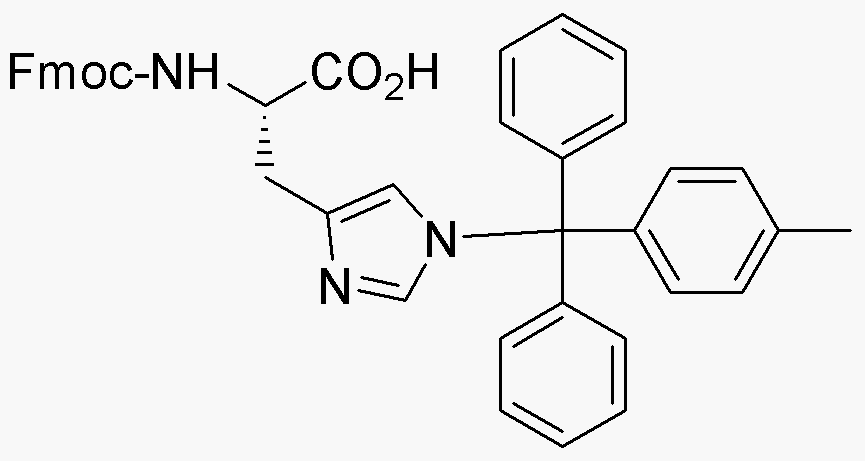Na-Fmoc-Nim-methyltrityl-L-histidine is widely utilized in research focused on:
- Peptide Synthesis: This compound serves as a key building block in the synthesis of peptides, particularly in solid-phase peptide synthesis, allowing for the creation of complex and functional peptides that are essential in drug development.
- Drug Development: Its ability to protect functional groups during chemical reactions makes it valuable in pharmaceutical research, where precise modifications of amino acids are necessary for developing new therapeutic agents.
- Bioconjugation: The compound is used in bioconjugation processes, enabling the attachment of peptides to other biomolecules, which is crucial for creating targeted drug delivery systems in cancer therapy.
- Research in Protein Engineering: Researchers utilize this chemical to modify histidine residues in proteins, enhancing their stability and activity, which is significant in enzyme engineering and biocatalysis.
- Diagnostic Applications: Its role in the synthesis of peptide-based probes aids in the development of diagnostic tools, improving the detection of diseases through targeted imaging techniques.
Información general
Propiedades
Seguridad y normativas
Aplicaciones
Na-Fmoc-Nim-methyltrityl-L-histidine is widely utilized in research focused on:
- Peptide Synthesis: This compound serves as a key building block in the synthesis of peptides, particularly in solid-phase peptide synthesis, allowing for the creation of complex and functional peptides that are essential in drug development.
- Drug Development: Its ability to protect functional groups during chemical reactions makes it valuable in pharmaceutical research, where precise modifications of amino acids are necessary for developing new therapeutic agents.
- Bioconjugation: The compound is used in bioconjugation processes, enabling the attachment of peptides to other biomolecules, which is crucial for creating targeted drug delivery systems in cancer therapy.
- Research in Protein Engineering: Researchers utilize this chemical to modify histidine residues in proteins, enhancing their stability and activity, which is significant in enzyme engineering and biocatalysis.
- Diagnostic Applications: Its role in the synthesis of peptide-based probes aids in the development of diagnostic tools, improving the detection of diseases through targeted imaging techniques.
Documentos
Hojas de datos de seguridad (HDS)
La SDS proporciona información de seguridad completa sobre la manipulación, el almacenamiento y la eliminación del producto.
Especificación del producto (PS)
La PS proporciona un desglose completo de las propiedades del producto, incluida la composición química, el estado físico, la pureza y los requisitos de almacenamiento. También detalla los rangos de calidad aceptables y las aplicaciones previstas del producto.
Certificados de análisis (COA)
Busque certificados de análisis (COA) ingresando el número de lote del producto. Los números de lote y de partida se pueden encontrar en la etiqueta de un producto después de las palabras "Lote" o "Lote".
Número de catálogo
Número de lote/lote
Certificados de origen (COO)
Este certificado de origen confirma el país en el que se fabricó el producto y también detalla los materiales y componentes utilizados en él y si se deriva de fuentes naturales, sintéticas u otras fuentes específicas. Este certificado puede ser necesario para cumplir con las normativas aduaneras, comerciales y regulatorias.
Número de catálogo
Número de lote/lote
Hojas de datos de seguridad (HDS)
La SDS proporciona información de seguridad completa sobre la manipulación, el almacenamiento y la eliminación del producto.
DownloadEspecificación del producto (PS)
La PS proporciona un desglose completo de las propiedades del producto, incluida la composición química, el estado físico, la pureza y los requisitos de almacenamiento. También detalla los rangos de calidad aceptables y las aplicaciones previstas del producto.
DownloadCertificados de análisis (COA)
Busque certificados de análisis (COA) ingresando el número de lote del producto. Los números de lote y de partida se pueden encontrar en la etiqueta de un producto después de las palabras "Lote" o "Lote".
Número de catálogo
Número de lote/lote
Certificados de origen (COO)
Este certificado de origen confirma el país en el que se fabricó el producto y también detalla los materiales y componentes utilizados en él y si se deriva de fuentes naturales, sintéticas u otras fuentes específicas. Este certificado puede ser necesario para cumplir con las normativas aduaneras, comerciales y regulatorias.


